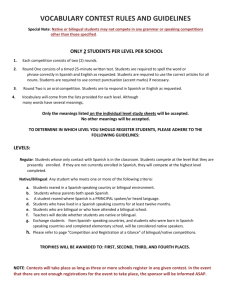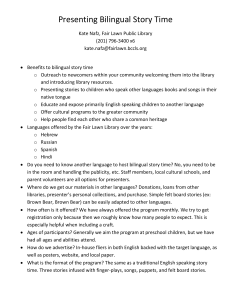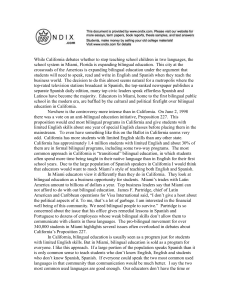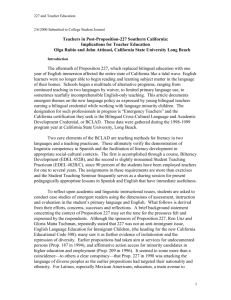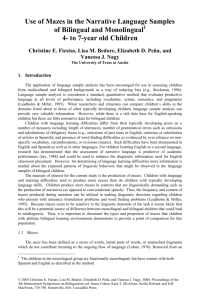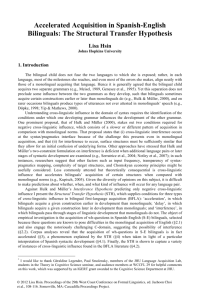File
advertisement
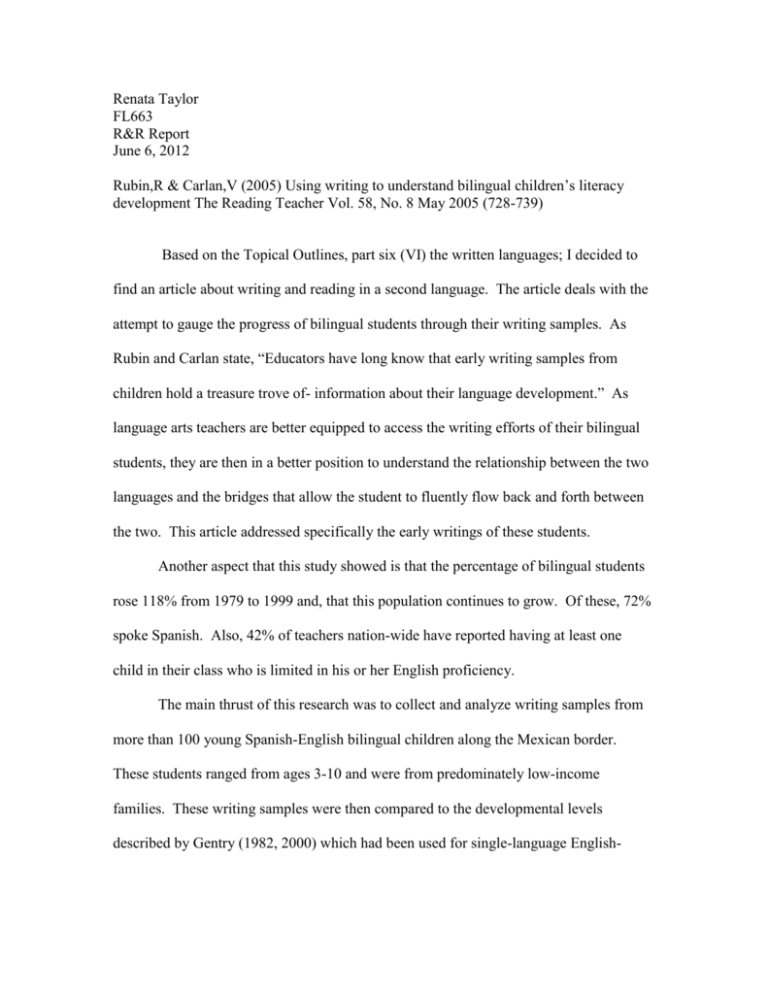
Renata Taylor FL663 R&R Report June 6, 2012 Rubin,R & Carlan,V (2005) Using writing to understand bilingual children’s literacy development The Reading Teacher Vol. 58, No. 8 May 2005 (728-739) Based on the Topical Outlines, part six (VI) the written languages; I decided to find an article about writing and reading in a second language. The article deals with the attempt to gauge the progress of bilingual students through their writing samples. As Rubin and Carlan state, “Educators have long know that early writing samples from children hold a treasure trove of- information about their language development.” As language arts teachers are better equipped to access the writing efforts of their bilingual students, they are then in a better position to understand the relationship between the two languages and the bridges that allow the student to fluently flow back and forth between the two. This article addressed specifically the early writings of these students. Another aspect that this study showed is that the percentage of bilingual students rose 118% from 1979 to 1999 and, that this population continues to grow. Of these, 72% spoke Spanish. Also, 42% of teachers nation-wide have reported having at least one child in their class who is limited in his or her English proficiency. The main thrust of this research was to collect and analyze writing samples from more than 100 young Spanish-English bilingual children along the Mexican border. These students ranged from ages 3-10 and were from predominately low-income families. These writing samples were then compared to the developmental levels described by Gentry (1982, 2000) which had been used for single-language English- speaking children and then to the developmental levels described by Ferreiro and Teberosky (1979/1982) for single-language Spanish speaking children. From this they found that the Pre-communicative Stage for both languages seems to be fairly similar. During the Semi- phonetic Stage, Rubin and Carlan noted that this level was one level in which the bilingual children differed significantly from their monolingual Spanish speakers. This is perhaps due to words in the Spanish language having more than one syllable whereas early words in English tend to have single syllables. They found that during the Phonetic Stage, that most children are at the realization that words are written differently in Spanish and English. In the Transitional Stage, it was noted that the bilingual students did BETTER than their monolingual counterparts, being able to flow back and forth between the two languages and describe things better. In the Conventional Stage, it was found that the children could actually be at two different stages depending on which language they used most. It was noted that Moll et al (2001) explained that this was indicative of the biliterate process not being a linear one. As I read this article, I can closely relate to it as I, too, am bilingual. Actually, I am quad lingual and English is not my mother tongue. I was raised in Albania and learned Italian by watching television during my youth. Therefore, I am better in speaking Italian than I am in reading it. I studied both English and Spanish by taking courses and am more fluent in both of these. In all of my languages, excluding Albanian, I am MORE fluent in speaking than I am in reading and MORE fluent in reading than in writing. I think this is probably true in any language. I have seen many Americans who cannot write in a fashion that makes sense but who seem to get around well when it comes to talking. I cannot say that I have actually studied their reading and writing practices, but I do know that they are far more fluent in the speaking ability than in their reading and writing ability. In light of this article, I do see where being bilingual serves the child in his ability to learn and I can see where his or her writing skills can give insight into the skills that the child possesses and can serve as a diagnostic tool which we can use to gauge the student’s development.




